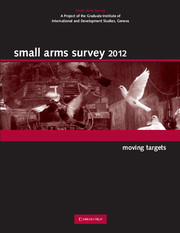Book contents
- Frontmatter
- Foreword
- Contents
- About the Small Arms Survey
- Notes to readers
- Acknowledgements
- Introduction
- Chapter 1 A Fatal Relationship: Guns and Deaths in Latin America and the Caribbean
- Chapter 2 When Business Gets Bloody: State Policy and Drug Violence
- Chapter 3 A Matter of Survival: Non-lethal Firearm Violence
- Chapter 4 Blue Skies and Dark Clouds: Kazakhstan and Small Arms
- Chapter 5 Between State and Non-state: Somaliland's Emerging Security Order
- Photo Essay. Troubled Waters: Somali Piracy
- Chapter 6 Escalation at Sea: Somali Piracy and Private Security Companies
- Chapter 7 Precedent in the Making: The UN Meeting of Governmental Experts
- Chapter 8 Piece by Piece: Authorized Transfers of Parts and Accessories
- Chapter 9 Point by Point: Trends in Transparency
- Chapter 10 Surveying the Battlefield: Illicit Arms in Afghanistan, Iraq, and Somalia
- Index
Chapter 10 - Surveying the Battlefield: Illicit Arms in Afghanistan, Iraq, and Somalia
Published online by Cambridge University Press: 05 February 2015
- Frontmatter
- Foreword
- Contents
- About the Small Arms Survey
- Notes to readers
- Acknowledgements
- Introduction
- Chapter 1 A Fatal Relationship: Guns and Deaths in Latin America and the Caribbean
- Chapter 2 When Business Gets Bloody: State Policy and Drug Violence
- Chapter 3 A Matter of Survival: Non-lethal Firearm Violence
- Chapter 4 Blue Skies and Dark Clouds: Kazakhstan and Small Arms
- Chapter 5 Between State and Non-state: Somaliland's Emerging Security Order
- Photo Essay. Troubled Waters: Somali Piracy
- Chapter 6 Escalation at Sea: Somali Piracy and Private Security Companies
- Chapter 7 Precedent in the Making: The UN Meeting of Governmental Experts
- Chapter 8 Piece by Piece: Authorized Transfers of Parts and Accessories
- Chapter 9 Point by Point: Trends in Transparency
- Chapter 10 Surveying the Battlefield: Illicit Arms in Afghanistan, Iraq, and Somalia
- Index
Summary
INTRODUCTION
Shortly after midnight on 6 August 2011, a Chinook helicopter carrying NATO and Afghan security forces was preparing to land near the Tangi Valley in Afghanistan. As the helicopter was descending, a Taliban fighter fired a rocket propelled grenade (RPG)1 at the dangerously exposed aircraft. The helicopter burst into flames, breaking apart as it plummeted to the ground. Thirty-eight people died in the crash, including 22 US special forces troops, making it the deadliest single incident of the war for US forces (King, Dilanian, and Cloud, 2011; Riechmann, 2011). An unclassified summary of a US military investigation into the incident confirms that the helicopter was hit by a ‘rocket-propelled grenade’ but provides no additional details (US CENTCOM, 2011b).
Most media accounts also refer to the weapon simply as a ‘rocket-propelled grenade’,2 but there are many kinds of RPGs from various sources and with very different capabilities. These differences matter—and not just in the case of the downed helicopter. Whether Taliban arsenals are filled with 30-year-old Soviet PG-7 rounds or PG-29V rounds for the deadly RPG-29 Vampir has profound implications, yet detailed data on illicit weapons in Afghanistan is scant.
These data gaps are not limited to Afghanistan. Details on the model, country of origin, age, and condition of illicit weapons are rare, and the little information that is available is usually anecdotal and incomplete. Thus, we are left to wonder what models of RPGs and other weapons are most readily available to terrorists, insurgents, and criminals. How technologically advanced are these weapons? Is it possible to keep them out of the hands of individuals and groups that are likely to misuse them? How old are they, and how many are still functional? Answers to these questions have the potential to shape efforts to stem the flow of illicit weapons and shed light on the threat they now pose. This chapter inaugurates a multi-year project to provide such answers through data-driven analysis of illicit small arms and light weapons worldwide.
- Type
- Chapter
- Information
- Small Arms Survey 2012Moving Targets, pp. 312 - 355Publisher: Cambridge University PressPrint publication year: 2012
- 2
- Cited by



